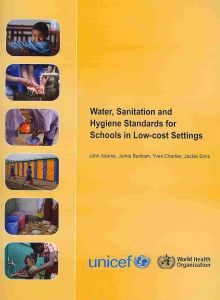
Published in: 2009
Publisher:
World Health Organisation (WHO)
Author:
Adams, J. et al.
Uploaded by:
SuSanA secretariat
Partner profile:
common upload
6964 Views
163 Downloads
Content - Summary
These guidelines deal specifically with water, sanitation and hygiene, and are designed to be used in schools in low-cost settings in low- and medium-resource countries to:
• assess prevailing situations and plan for required improvements;
• develop and reach essential safety standards as a first goal; and
• support the development and application of national policies.
The guidelines are written for use by education managers and planners, architects, urban planners, water and sanitation technicians, teaching staff, school boards, village education committees, local authorities and similar bodies.
Children’s ability to learn may be affected by inadequate water, sanitation and hygiene conditions in several ways. These include helminth infections (which affect hundreds of millions of school-age children), long-term exposure to chemical contaminants in water (e.g. lead and arsenic), diarrhoeal diseases and malaria infections, all of which force many schoolchildren to be absent from school. Poor environmental conditions in the classroom can also make both teaching and learning very difficult.
Bibliographic information
Adams, J. et al. (2009). Water, sanitation and hygiene standards for schools in low-cost settings. World Health Organisation (WHO)
Filter tags
English Guidelines and manuals Practitioners Recommended by SuSanA (other than SuSanA publications) Schools Sustainable WASH in institutions and gender equality (WG7)














